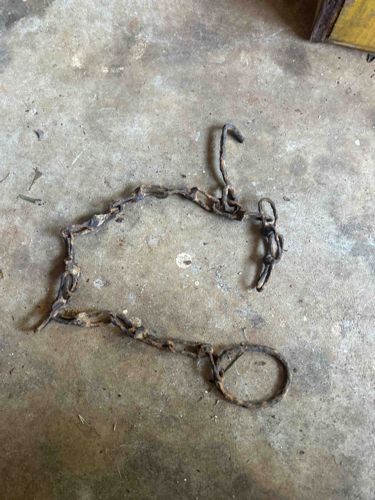
Vintage Animal Tethering Chain
This is a highly corroded vintage metal chain, likely an animal tethering chain or a general-purpose utility chain. It appears to be approximately 3 to 4 feet in length when laid out, although its irregular and stiffened form makes an exact measurement difficult from the image. The chain is constructed from individual open-link segments, which vary slightly in shape and size, suggesting either rudimentary forging techniques or significant distortion due to age and exposure. The material is ferrous metal, most likely iron or a low-carbon steel, evidenced by the pervasive, heavy reddish-brown and dark brown rust that thoroughly encapsulates nearly every surface. One end of the chain terminates in a distinct, elongated, and curled S-shaped hook, approximately 3-4 inches long, designed for looping onto or around an object. The opposite end features a fixed, circular metal ring, roughly 2-3 inches in diameter, which would typically connect to an animal's collar or a different fastening point. The entire surface of the chain, hook, and ring is covered in a thick layer of oxidation, resulting in a deep, crusty, and heavily textured patina. This severe corrosion indicates prolonged exposure to moisture and the elements. There is no visible evidence of original paint, plating, or any other finish. Due to the extensive rust build-up, many of the links are stiff and appear partially fused in places, significantly compromising the chain's inherent flexibility and original structural integrity. While no complete breaks are immediately discernible, the material appears brittle, and substantial material loss due to rust is evident across many links. There are no discernible manufacturer's marks, stamps, or significant decorative elements, which is common for utilitarian items of this nature and age, further obscured by the heavy corrosion. Based on its crude construction and advanced state of corrosion, this piece likely dates from the late 19th to early 20th century, serving as a functional piece of agricultural hardware. Its current condition suggests it is now primarily an antique or historical artifact rather than a functional tool.
AI-Generated Appraisal Disclaimer
Estimated Value
$20-50
Basic Information
Category
Agricultural Hardware
Appraised On
November 29, 2025
Estimated Value
$20-50
Item Description
This is a highly corroded vintage metal chain, likely an animal tethering chain or a general-purpose utility chain. It appears to be approximately 3 to 4 feet in length when laid out, although its irregular and stiffened form makes an exact measurement difficult from the image. The chain is constructed from individual open-link segments, which vary slightly in shape and size, suggesting either rudimentary forging techniques or significant distortion due to age and exposure. The material is ferrous metal, most likely iron or a low-carbon steel, evidenced by the pervasive, heavy reddish-brown and dark brown rust that thoroughly encapsulates nearly every surface. One end of the chain terminates in a distinct, elongated, and curled S-shaped hook, approximately 3-4 inches long, designed for looping onto or around an object. The opposite end features a fixed, circular metal ring, roughly 2-3 inches in diameter, which would typically connect to an animal's collar or a different fastening point. The entire surface of the chain, hook, and ring is covered in a thick layer of oxidation, resulting in a deep, crusty, and heavily textured patina. This severe corrosion indicates prolonged exposure to moisture and the elements. There is no visible evidence of original paint, plating, or any other finish. Due to the extensive rust build-up, many of the links are stiff and appear partially fused in places, significantly compromising the chain's inherent flexibility and original structural integrity. While no complete breaks are immediately discernible, the material appears brittle, and substantial material loss due to rust is evident across many links. There are no discernible manufacturer's marks, stamps, or significant decorative elements, which is common for utilitarian items of this nature and age, further obscured by the heavy corrosion. Based on its crude construction and advanced state of corrosion, this piece likely dates from the late 19th to early 20th century, serving as a functional piece of agricultural hardware. Its current condition suggests it is now primarily an antique or historical artifact rather than a functional tool.
Related Tags
Get Your Items Appraised
Instant estimates of your treasures with AI-powered instant appraisals